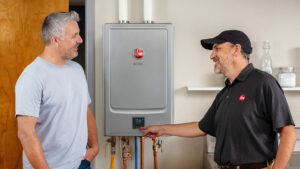How to drain a rheem water heater? Draining a Rheem water heater is an essential maintenance task to ensure its efficiency and longevity. Over time, sediment and mineral deposits can accumulate at the bottom of the tank, reducing the heater’s efficiency and potentially causing damage.
Here is a detailed, step-by-step guide on how to properly drain your Rheem water heater.
Tools and Materials Needed:
- Garden hose
- Screwdriver
- Bucket (if needed)
- Pipe wrench or channel-lock pliers
- Teflon tape (optional, for re-sealing any connections)
- Towels or rags
- Safety goggles and gloves

Step-by-Step Process:
1. Turn Off the Power Supply
If you have an electric water heater, locate the circuit breaker panel and turn off the power supply to the water heater. This is crucial to prevent any electrical accidents while working on the heater. For gas water heaters, set the gas valve to the “pilot” position to ensure that the burner does not ignite during the draining process.
2. Turn Off the Water Supply
Locate the cold water supply valve, typically found at the top of the water heater, and turn it off. This valve is usually a lever or a dial. Turning it off stops more water from entering the tank.
3. Let the Water Cool
It’s important to let the water inside the tank cool down to avoid any risk of burns. Ideally, you should let the water heater sit for a few hours after turning off the power and water supply. You can expedite the cooling process by running hot water from a tap for a few minutes.
4. Attach a Garden Hose
Attach one end of a garden hose to the drain valve located near the bottom of the water heater tank. Ensure that the hose is securely connected to prevent any leaks. Place the other end of the hose in a suitable drainage location, such as a floor drain, a driveway, or an outdoor area. Make sure the drainage area can handle hot water and any sediment that may come out.
5. Open a Hot Water Faucet
To prevent a vacuum from forming inside the tank and to allow air to enter, open a hot water faucet in your home. This step ensures that the water will flow smoothly out of the tank.
6. Open the Drain Valve
Carefully open the drain valve on the water heater tank. Water should begin to flow out through the hose. Be cautious, as the water may still be hot. If the water does not flow, you may need to open the pressure relief valve at the top of the tank to allow air to enter and facilitate draining.
7. Flush the Tank (Optional but Recommended)
To remove any remaining sediment, you can perform a flush:
- After the initial draining, briefly turn on the cold water supply with the drain valve still open. This will stir up any sediment at the bottom of the tank.
- Let the water run for a few minutes until it runs clear, indicating that most of the sediment has been flushed out.
- Turn off the cold water supply again and let the tank drain completely.
8. Close the Drain Valve
Once the water has completely drained out, close the drain valve by turning it clockwise. Ensure it is tightly closed to prevent any leaks when the tank is refilled.
9. Disconnect the Hose
Carefully disconnect the garden hose from the drain valve. Be prepared for any residual water that may still be in the hose.
10. Refill the Tank
Turn the cold water supply back on to begin refilling the tank. Leave the hot water faucet open during this process to allow air to escape from the tank. You will know the tank is full when water begins to flow steadily from the open faucet.
11. Check for Leaks
While the tank is refilling, inspect the drain valve and any connections for leaks. If you notice any leaks, tighten the connections or apply Teflon tape to the threads if necessary.
12. Restore Power or Gas Supply
For electric water heaters, return to the circuit breaker panel and turn the power supply back on. For gas water heaters, turn the gas valve from the “pilot” position to the “on” position. Follow the manufacturer’s instructions for relighting the pilot light if necessary.
13. Allow the Water to Heat Up
It may take a few hours for the water heater to reach its set temperature. During this time, avoid using hot water excessively to allow the heater to heat up efficiently.
Safety Precautions
- Wear Safety Gear: Always wear safety goggles and gloves to protect yourself from hot water and sharp edges.
- Work in a Well-Ventilated Area: If you are working with a gas water heater, ensure the area is well-ventilated to avoid gas buildup.
- Check Manufacturer’s Instructions: Refer to your Rheem water heater’s manual for any specific instructions or precautions.
Tips for Maintenance
- Regular Draining: Drain your water heater at least once a year to prevent sediment buildup.
- Inspect Components: Periodically check the anode rod, pressure relief valve, and other components for wear and tear.
- Adjust Temperature: Set the thermostat to a moderate temperature (120°F) to reduce energy consumption and prevent scalding.
Conclusion
Draining a Rheem water heater is a straightforward process that can significantly enhance its performance and lifespan. Regular maintenance not only improves efficiency but also helps in early detection of potential issues. By following these detailed steps, you can ensure your water heater remains in optimal condition, providing reliable hot water for your household.
Read Also.How Can I Remove a Sink Stopper If It’s Stuck?